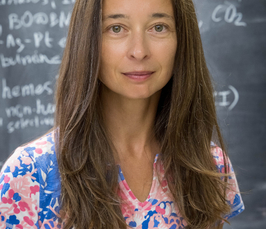Dynamic catalytic interfaces: ensembles of metastable states break the rules of catalysis
- Date: Jun 9, 2022
- Time: 03:00 PM c.t. (Local Time Germany)
- Speaker: Prof. Dr. Anastassia Alexandrova
- Department of Chemistry & Biochemistry, UCLA, Los Angeles, USA
- Location: Building M, Richard-Willstätter-Haus, Faradayweg 10, 14195 Berlin
- Room: Seminar Room
- Host: Interface Science Department

Multitude of metastable states in this ensemble dictate the catalytic activity, selectivity, and durability, as well as size-specific behaviours. Every intermediate of the catalyzed reaction is bound to a different ensemble-state of the catalyst. For every reaction step, the most active catalyst state is not the most stable. Thus, catalyst dynamics is an essential part of the catalytic process. Many rules of catalysis need a revision within this new paradigm. Scaling relations routinely break down. Phase diagrams contain many structures per phase. Operando spectroscopy interpretation needs to be done differently, and it may miss the true active sites because it reports on the majority sites that may not be most catalytic. The theory of sintering and the idea of magic numbers need a revision. Etc.
Several catalytic systems will be shown to illustrate these points: semiconductor-supported Pt clusters and cluster alloys used for hydrocarbon dehydrogenation for endothermic cooling, Cu oxide clusters used for oxidative dehydrogenation, and clusters on graphite used for ORR. Most of this work is done in close collaboration with experiments that we either explain, or that tests our predictions. Some of our results will hopefully prompt experimental developments. For example, detecting dynamic minority species of the catalytic interface remains a challenge.